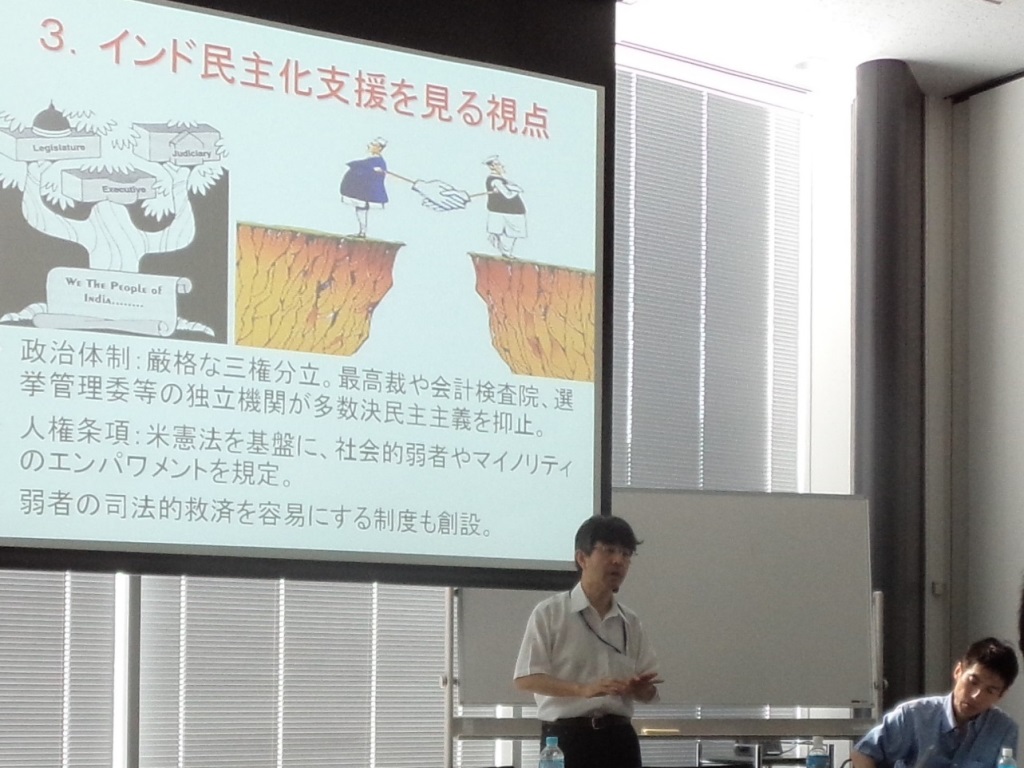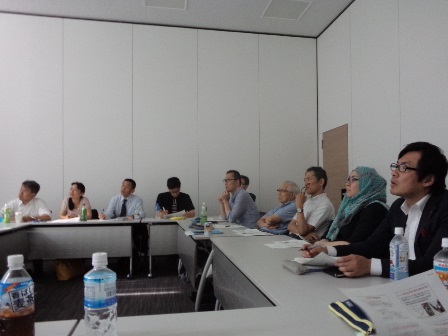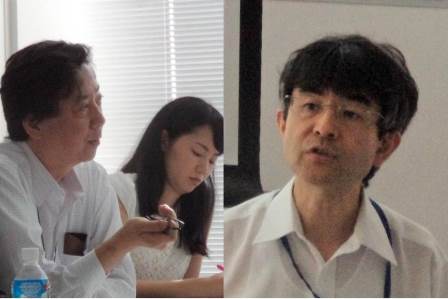According to Hiroaki Shiga of JICA Research Institute, the inclusive and pluralistic democracy of India provides the role model for other developing countries and the India’s constitution has been studied by Singapore, Malaysia, Tanzania, Uganda, South Africa, Nepal, Bhutan and other developing countries (Reported byTakashi Kamishiro).

On 2 July 2016, on the occasion of the 20th study session of the Global Peace Academy, the meeting invited Mr. Shiga, Senior Research Fellow of Japan International Cooperation Agency (JICA) Research Institute, for the lecture on the contribution of India to the democratization of other nations. The lecture and the following discussion drew the active participation from about 30 peacebuilding scholars and practitioners.

Emerging donor countries, such as India and China, have recently drawn interests. Although the initial aggravated image of their development cooperation strategy has been modified as progressing the empirical researches, there is still a room for better understanding by dismantling certain ignorance and prejudgments. There are some negative references to the development cooperation by emerging donors as “rogue aid” (Naim, Foreign Policy 2007). There is little research about how the philosophy and institutional and political experience of these emerging donor countries are contributing to the improvement of the governance, political, economic and social development of other developing countries. Such trend is underlined by a prejudgment that the principles, systems, experiences for the development are supposed to come only from the industrialized nations.
In this line, the lecture focused on the India’s democratization assistance to other developing countries.
Following the recent trends, such as the stagnation of “The Third Wave” and the entrenchment of the authoritarian regimes in the 2000s, and the downfall of democratization support led by the Western countries after the invasion of Iraq in 2003, there is an increasing interest in how India would be able to contribute to the cause of democratization of developing countries.
On the other hand, in fact, their evaluation on the India’s democratization support in the Western literature is low, and there are some criticisms, such that India is not a sufficient counterbalance to the authoritarian regimes of China and Russia (Grävingholt et al. 2011), that India does not play a role enough to support the neighboring countries in the democratization (Burnell and Schulumberger 2011), and that the India’s democracy is a mere corrupted clientelism and cannot be an example for other countries (Faust and Wagner 2010).
The background of this criticism lies in the facts that while the developed countries value the visible transition from the authoritarian regime to the democratic system and the support to opposition parties, NGOs and local media, India supports for the consolidation of the democracy after the transition to the democratic system. In addition, there is no research regarding whether the India’s democratic experience has become the examples for other developing countries.
As the elements of the democracy, Europe and the US make much account of free, fair and periodic elections, while in the ethnically and religiously divided society; elections often result in a majoritarian democracy where no interchangeability of the majority and the minority is guaranteed. Worse still, constitutional nationalism, in which certain ethnic or religious groups constitutionally entrench their privileged status, tends to be prevalent (Bhutan, Sri Lanka, etc.). Majoritarian democracy and constitutional nationalism results in the mounting dissatisfaction of minorities, and civil wars ensue.
The first characteristic of the India’s democracy is the inclusive and pluralistic democracy. Prime Minister Manmohan Singh, in a speech at the inauguration ceremony of UN Democratization Fund in 2005, stated that the India’s democracy was not a majoritarian democracy, but the one which encompassed also minorities and vulnerable populations, and that such a type of democracy was essential for the development.
The second characteristic is the establishment and maintenance of a sound constitutional democracy to ensure the inclusive and pluralistic democracy. The Indian Constitution has not been suspended or abolished since its entry into force in 1950, and the judicial power tends to actively exercise the review of the constitutionality of the legislative measures. Moreover, there are other systems, such as the strict separation of three powers, independent bodies to contain abusive majoritarian democracy, human rights clauses to protect those who are socially disadvantaged and minorities and judicial relief system. An African constitutional scholar values the Indian Constitution, which was formed under the low development and cultural diversity context, as an alternative to the constitutions of the developed countries, and praised that it pioneered the innovative era of constitutional design.
There is no scholarly agreement on why the India’s constitutional democracy has withstood the test of time and the test of fissiparous society. Here I only present three factors which seemingly contribute to the persistence of the constitutional democracy in India: India enjoyed the limited local autonomy and experienced the democratic governance at the end of the British colonial era; the sound balance between the centralization and the decentralization is maintained; and traditionally the military does not intervene the politics.

There are two roles which India plays for the promotion of the democratization. First, it is as the role model of the constitutional democracy for other developing countries. The India’s constitution was studied by Singapore, Malaysia, Tanzania, Uganda, South Africa, Nepal, Bhutan, and so forth. Historically, India supported the process of drafting the constitutions of the neighboring countries (except Pakistan) and the African countries. The example was that India dispatched Dr. Rau; a member of the constitution’s drafting committee, to Burma (now Myanmar) on its independence even before the entry into force of the India’s own constitution. In addition, the judicial precedents of the India’s Supreme Court are cited in the important judicial cases in other countries.
India has the Public Interest Litigation (PIL) system, a unique judicial system which has a basis in the Constitution and has been developed progressively by the rulings of the Supreme Court, in order to facilitate socially vulnerable groups’ access to justice. India promotes the introduction of PIL to other developing countries through the UN Democracy Fund (India and US major donors) as many developing countries have widely introduced it.
Secondly, it is as the support to the consolidation of the democracy. India does not provide a support to promote the democratic transition by following the principle of the noninterference in the domestic affairs, but instead, it provides a support to consolidate the democracy after the democratic transition. The Indian Technical & Economic Cooperation Programme (ITEC) of the Ministry of Foreign Affairs of India coordinates the activities. As a part of such efforts, the Election Administration Committee offers the support in the areas, such as electoral fraud prevention and the facilitation of voting by the minorities and socially disadvantaged people through voters’ education programs. The Bureau of Parliamentary Studies and Training (BPST) of the Parliament of India invites trainees from other developing countries to the training. Between 2010 and 2015, 566 persons from 87 countries, including South Asia, Sub-Saharan Africa, and the former Soviet Union countries, participated in the training.
Recently, India is actively supporting the democratization of Afghanistan in order to prevent the establishment of the extreme Islamic regime by valuing the inclusive and pluralistic democracy which encompasses religious and ethnic minorities. However, domestically, there is a voice to concern about the religious tolerance under the current government of Prime Minister Modi. Ensuring the balance to advance the democratization externally and domestically is the issue of India under the current government of Prime Minister Modi.
It is the utter prejudice that the institutions, wisdom and experience helpful for the development come only from the developed countries. Although Japan has been contributing to the international development assistance, it is necessary to acknowledge that the monopoly of international aid by the developed countries has already ended. For instance, in Asia, the Japanese think-tank institutions lag behind those of South Korea, Singapore and China. It is necessary for Japan to keep abreast of the intellectual exchanges among the developing countries not to be left behind by the emerging donors.
It is observed that the quality of the India’s judiciary remains high from the beginning. The example was observed in the International Military Tribunal for the Far East, where Judge Radha Binod Pal of India argued the innocence of the accused because the crimes against humanity and the crimes against peace were the ex-post facto laws. Mr. Shiga precisely pointed out that the India’s support to other developing countries has been carried out in focus of the democratic support within the arrangement so-called South-South cooperation. It is often said that democracy does not work in developing countries, but Mr. Shiga clearly showed that India’s democracy has been functioning since its independence despite a huge population with many ethnic groups and religions. Mr. Shiga also showed that India’s inclusive and plural constitutionalism could be a model for other developing countries, and this soft power assistance has a clear distinction from China’s infrastructure assistance. Questions were made with regard to (1) Concrete constitutional mechanisms to guarantee social and economic human rights and any comparative study with other countries, (2) Reason for functioning the check and balance among the three branches of the state based on a rule of law, (3) Reason why the democracy has not been fully established in other developing countries which India has supported, (4) Impact of the Muslim population’s move to Pakistan and Bangladesh on the India’s domestic stabilization, and (5) Concern for India to become unstable in case of the increase of the ethnic nationalism.
(Mr. Shiga) There is no scholarly agreement on the reason why the constitutional democracy has been so persistent in the seemingly hostile environment of India, and I have to confess that I myself do not have persuasive answers. Without doubt, the strong judiciary power in India, which Mr. Inoue has rightly pointed out, can partly explain the endurance of constitutional democracy in India. The richness of Indian legal profession is evident in the history that many Indian lawyers, such as Mohandas Gandhi, dedicated in the anti-apartheid activities in South Africa and then they returned to India to participate in the movement for independence. It is true that the democratic consolidation does not necessarily go well in the countries which India supports. If there is no ground sound enough to build a democratic society, the democratic transition and consolidation will not happen.
Several participants commented on the presentation and asked for clarifications. There are some who raised certain issues for discussion.
The first discussion was made about the backgrounds that India supported other developing countries in the democratization process. Mr. Shiga commented that the India’s intention was to differentiate itself from other BRICS countries, especially from China, and the implementation of the democratization support was one of the diplomatic tools to achieve this goal. Another intention behind would be to buy in the US’s interest in India with regard to the UN Security Council’s permanent seat and the Non-Proliferation Treaty (NPT). India supports Nepal and Bhutan in the infrastructure development such as hydropower stations as well as their democratization process. Anxious about the increasing military and economic presence of China, India actively supports Sri Lanka, Bangladesh and Myanmar.
Certain participants asked for the detailed explanation about the inclusive and pluralistic democracy, Public Interest Litigation (PIL) and the check and balance of the three powers of the government. Mr. Shiga explained that Indian constitutional institutions were the hybrid of imported elements from the UK and the US and the indigenous innovations. For example, the PIL, an institutional device to facilitate the access to judicial service by the socially disadvantaged and thus to realize the inclusive and pluralistic democracy, is the Indian innovation. It is a right argument that strong judiciary runs the risk of the rule by elites, and actually there are arguments against the judicial elitism in India. However, the current balance among the three branches of power seems appropriate, and judiciary does not override the power of the parliament. The India’s judiciary sometimes overturns the rules and the obligations imposed in the international sphere, but such circumstances do not happen so often.
Concerning the question about the India’s diplomatic positions as to the democratization support, Mr. Shiga explained that India regarded the international assistance as the South-South “cooperation” rather than the “assistance.” On the other hand, India also takes a diplomatic position, so called Indian “Monroe Doctrine” to maintain the hegemony in the region, and does not wish other countries to intervene the region’s countries, such as Nepal and Bhutan. In fact, the India’s cooperation towards the neighboring countries is accounted for 50% of the global amount of its development cooperation.
For the skeptic views on the India’s strategy to assist the democratization of other developing countries, due to the India’s domestic social issues (low HDI, caste system, etc.), Mr. Shiga acknowledged that it was undeniable that India was lagging behind China in terms of HDI, and constitutional democracy had not been functioning well to ameliorate the abysmal situation, however, he added that the Indian counterargument is that no one died from famine since the democratization (independence) in 1947 in India, while millions were killed in China for politically-induced famine in the 1960s. There is fierce debate about the causal relationship between democracy and economic growth and human well-being, and there is no definite answer so far.
The discussion touched upon the close relationship between political parties and lobbying groups. There is a close relationship between political parties and lobbying groups in India. Mr. Shiga confirmed that Indian politics was the interest group politics. To be sure, there are organizations to promote the interests of specific ethnicities and religions, but there are so many cleavages inside the ethnic and religious groups that they do not form a single force to exercise enough influence in the politics.
The discussion also referred to the elitism in India. There is indeed elitism in India of the British origin, and can be observed in every branch of the government, including judiciary, administration, and the parliament. However, it seems that there is a kind of consensus in the society for the need of elitism in such a huge and fragmented society.
At the end of discussion, Professor Hasegawa pointed out that democracy consisted of two principles: representative form of governance, and rule of law and human rights. Government is formed by representatives who are elected by people and administer the state by rule of law and through protection of human rights. Human rights consisted of civil, political, social, economic and cultural freedoms.
Based on his experience working in Nepal for three years from 1978 to 1980, Professor Hasegawa noted the dominant position India held in South Asia. The gradual transformation in India’s ideology in economic management has resulted in noticeable increase in productivity and gross national product. During an international conference held in Hong Kong in June 2016, participants debated the rising power of India and China and whether or not they could become not only hegemons in the region respected leaders.